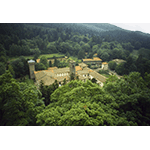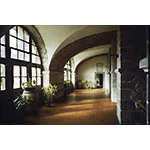Abbazia di Vallombrosa [Abbey of Vallombrosa]
Giovanni Gualberto, monk of San Miniato, reached Vallombrosa in 1036. The forest of chestnut trees, silver fir and beach trees immediately became the destination of pilgrimage for clergymen and laymen, attracted by the rigid monastic life led and preached by Giovanni Gualberto. Already in 1039, the abbess Itta donated the land to build the monastery and church, consecrated in 1051, while in 1055 Pope Victor II recognised the Benedictine Congregation of Vallombrosa.
Reconstructed around the mid 15th century by the abbot Francesco Altoviti, the monastery grew very rich through the centuries, becoming between the 17th and 18th century an important point of reference for scientific culture in Tuscany. It appears that around 1578, by order of his father, Galileo Galilei sojourned here, perhaps as a novice.
The Vallombrosans conducted weather observations for the Medici weather station network (1654-1667), the first to be instituted in Europe. The Biblioteca Nazionale Centrale di Firenze conserves several documents (marked "Instruments from Vallombrosa in the 60’s of the 17th century by several monks, including don Filiberto Casini and don Antonio Petreschi"), which record climatic conditions: «The wind continues; freezing cold in the nursery … cloudy, windy, freezing cold …».
Botanical studies were also important. Quite noteworthy between the 17th and 18th century was the activity of Virgilio Falugi and, especially, of Bruno Tozzi, friend of the great botanist Pier Antonio Micheli, and correspondent of the major botanists of Europe. Tozzi and other monks studied and depicted the vegetal species of the region with great ability.
Following the Napoleonic suppression of 1808, the monastery was repristinated in 1815, and then transferred to the State in 1866 as headquarters of the National Forestry Institute. The Benedictine monks returned to Vallombrosa only after World War II.
****************************
Texts by Alessandro Tosi
English translation by Victor Beard
Last update 15/mag/2008





